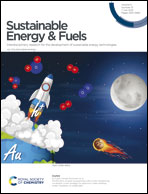The effect of core engineering on triphenylamine-derivative-based dopant-free hole-transporting materials for perovskite solar cells: from theoretical calculations to experimental research†
Abstract
Computational approaches for the design of small-molecule triphenylamine-derivative-based hole-transporting materials (HTMs) are a highly efficient way to acquire potential HTMs for perovskite solar cells (PSCs). In this work, based on our developed theoretical model, a class of potential arylamine-derivative-based HTMs (CQ1–CQ3) with different conjugated π-bridge groups was designed, and the materials exhibited better performance in comparison with the parent HTM X25. To verify the computational model and obtain the potential HTMs, the promising HTM CQ2 was synthesized and applied in a PSC device. The results reveal that the experimental data we obtained in this paper reproduced the theoretical results, such as the frontier molecular orbital energy, optical properties, and hole mobilities, very well. Compared to the power conversion efficiency (PCE) (14.39%) of the X25-based PSC, the dopant-free CQ2-based PSC exhibits a better PCE of 15.21% because of its improved short-circuit current and fill factor values. This study demonstrates that computational approaches are a feasible way to obtain potential HTMs in order to economize the cost of development of new HTMs.



 Please wait while we load your content...
Please wait while we load your content...